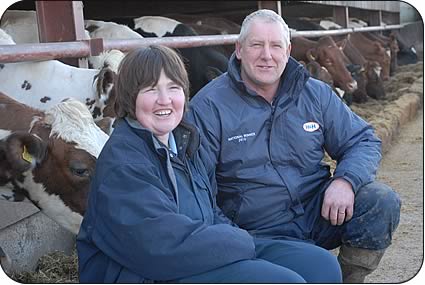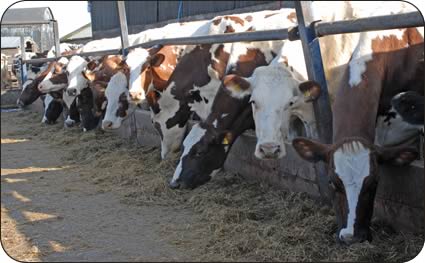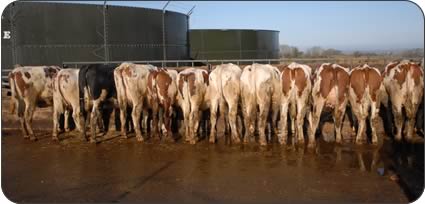Jennifer MacKenzie is an agricultural photo journalist with almost 30 year's experience. Operating from her base in Cumbria, Jennifer undertakes mainly industry-related freelance writing and photography.
Traditional breeders with their eye on the future
Ayrshire cows are a family tradition for Christine and David Sanderson
and the couple are aiming to breed modern type cattle with good lifetime
yields.
 |
| Christine and David with the milkers |
Ayrshire breeding goes back more than 30 years at the 207-acre all grass
Thackthwaite Hall, Wigton, Cumbria, where Christine and David milk 134
cows in their prizewinning pedigree Sandersons herd.
Gradually re-building the herd after losing all their livestock during
2001’s food and mouth epidemic, the couple are content not to push
their lactational yields but are looking for a long-lived, modern dairy
cow which can produce a total yield of 50,000 litres.
The herd averages 7,000 litres a cow and with the breed’s natural
butterfat producing ability with current constituent averages running at
4.3 per cent with 3.37 protein, they are expecting to achieve a premium
from their new milk buyer from April, Milk Link.
Dedicated stockswoman Christine began milking cows when she was just eight
years old, and when she left school at 16 her parents Mary and Chris Todd
began grading up their black and white cattle to Ayrshires, following Mary’s
family tradition with the breed.
Mary still helps on the farm, feeding the calves, with other part time
help from Karl Stephenson and Barry Williams.
By 2001, Christine and David had established the nucleus of their own Ayrshire
herd with cows they had bought from the Whitefords’ Middle herd at
Brampton, Carlisle.
 |
| Christine and David with show cow Middle Emerald Mr which won the Ayrshire championship at the National All Breeds Show |
Their Sandersons herd was re-established primarily with the purchase of
the Waxham herd of 105 milking cows, mostly in their second lactation and
10 of which are in the herd today, and two heifers. Further purchases were
made from the Waxham youngstock sale in Carlisle as well as other individual
purchases from herds in Cumbria and Scotland.
“The Waxham herd were different type of cows to the pure Ayrshires
we had previously and we also wanted to produce more milk from these bigger,
blended cows,” said Christine, who has been secretary of the Cumberland
Ayrshire Breeders’ Club for 14 years.
Nine years on and the Sandersons are now breeding most of their replacements,
currently bringing in up to 30 heifers a year to replace more of the older
cows, some of which are in their ninth lactation.
 |
| The Sandersons herd milkers |
Still open to select purchases of top cows which catch their eye, the
Sandersons have invested in two Middle cows at the Beeston Castle sale,
Emerald Mr at the December 2008 sale, the most paid at 5,200gns, which
lifted the Ayrshire championship at the National All Breeds Show at Stoneleigh
in February this year, and Georgette, purchased in 2007 for 5,000gns in
partnership with Chris’s uncle, Nick Armstrong, of Mosedale End,
Mungrisdale, Penrith.
Georgette was breed champion four times at the Westmorland County Show,
winning the dairy interbreed once and she was also interbreed dairy champion
at the Cumberland County Show.
Waxham cows have won the breed championship twice at the Great Yorkshire
Show.The Sandersons have also won the championship with a home bred cow
and a home-bred heifer won the junior championship.
Despite re-establishing the bloodlines, the herd has won the large section
of the Cumberland Ayrshire Breeders’ Club each year since 2001 with
the exception of 2007 when the competition was cancelled because of another
foot and mouth outbreak. The herd was also the overall winner in 2009.
 |
| Ayrshire heifers |
The herd is 50-50 Ayrshire Holstein cross cows with most registered in
the Ayrshire herd book and the Sandersons are keen to maintain at least
this proportion of Ayrshire bloodlines to breed robust but large animals
which can withstand their heavy farm.
“It’s a question of how far do we go in using Holstein blood
to suit our farm. It’s a heavy farm and we want cows which are modern,
tall and sharp but still have plenty of body and a bit of will to live.
It’s a happy medium,” said Christine.
David added: “We are happy to stick around the 7,000 litre lactational
yield, not pushing the cow too hard and taking it out of her. Our benchmark
is 50,000 litres in a lifetime and at that we reckon she doesn’t
owe us anything.
“At that level we maintain good quality butterfats and protein which,
because of the breed’s natural ability, does not cost us anything
in feed supplements, and we reduce our level of replacements. We estimate
it costs us at least £900 to bring a heifer to calving. We have got
to be realistic.”
Also, the Sandersons do not believe in calving their heifers too young
but allowing them to grow. Most calve at 30 months old and with the herd
now achieving a younger profile and satisfying the Sandersons’ breeding
aims, more newly-calved heifers will be sold through Borderway, Carlisle.
Stock bulls are used on the herd. The first was Syke Duty Free, bought
from Willie Templeton followed by a Barr bull from Alex Kirkpatrick. Home-bred
bulls have followed with Sandersons George, out of Georgette, and another
out of a Waxham Esther cow, Sandersons Extra Special. Sandersons Lost Forever
was out of Waxham Lizzie. Young bulls are also sold art around 14 months
old for breeding.
Some AI bulls have been used including Changue Tryst, Auchensale Star Performer,
Carnell Bright Crown and Red and White sires TBVQ Rubens, KC Roses Chatters,
Llandudno Park Talent, Poos Stadale Classic and Rosedale Rampage Red.
Thackthwaite Hall is 600ft above sea level and the cows are housed from
October to April and fed a semi complete diet of chopped round bale silage
with a blend and brewers grains, compiled by nutritionist Ian Wozencroft,
of New Breed UK. They are topped up in the parlour to a maximum of 10kg
and 45 litres of milk.

